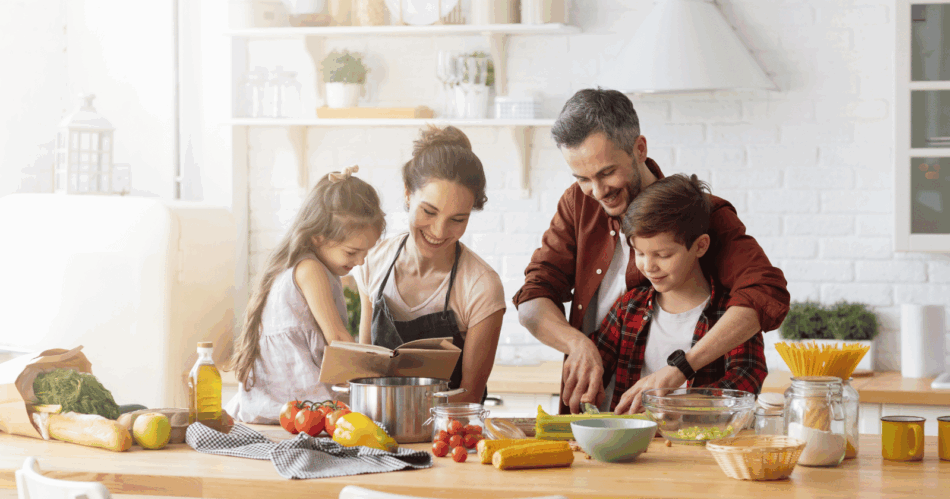I come from a family where meals were loud, messy, and shared. Beans simmering on the stove. Tortillas puffing on the comal. My abuela humming along to rancheras while stirring mole. Food wasn’t just food—it was identity.
So when I decided to raise our kids plant-based, I knew it wasn’t just about tofu versus chicken. It was about what values would sizzle on the skillet beside them.
But here’s the twist: my partner didn’t make the same switch. He still enjoys his carne asada tacos, still orders cheese-heavy enchiladas when we’re out. And he’s a wonderful dad.
So how do we raise two kids in a mixed-diet household without making dinnertime feel like a battleground?
Here’s how we’ve navigated it—through a lot of taste tests, real conversations, and more than one spilled smoothie.
We decided on our core values first, not our exact menu
Before we talked meal plans, we talked why. Why does plant-based eating matter to me? (Answer: climate, animal welfare, and long-term health.) Why does flexibility matter to him? (Answer: honoring his own upbringing and cultural food memories.)
Instead of trying to convert each other, we got clear on the values we do share. We both want our kids to grow up:
-
With a healthy relationship to food
-
Curious about where their meals come from
-
Able to make informed, conscious choices
So we agreed: plant-forward would be the foundation. Not strict veganism for everyone—but a shared home base.
In practical terms, that means:
-
Our groceries and home-cooked meals are fully plant-based.
-
When dining out, everyone gets to choose.
-
We talk about food systems often—who grows our food, how animals are treated, what nourishes our bodies and planet.
This values-first approach gave us something much stronger than a meal plan. It gave us a compass.
We meal prep together—with room for variation
Every Sunday, we block out an hour to prep basics. Think roasted veggies, lentil stews, oat bars, and tofu nuggets that even my skeptical 6-year-old loves.
Here’s the key: we make room for side-by-side variety without doubling the work.
Take tacos night:
-
Base: corn tortillas, avocado, chopped veggies, salsa
-
Protein options: spiced black beans for the kids and me, grilled carne asada for my partner
-
Optional toppings: vegan queso, lime crema (non-vegan), pickled onions
We set it up buffet-style. Everyone assembles their plate based on preference.
This simple structure lets us cook mostly plant-based while still acknowledging our different habits. It also teaches our kids that flexibility and thoughtfulness can share a plate.
We let the kids explore—but with a plant-based anchor
Our kids are both under ten, which means their food curiosity is wild. One week they’re obsessed with seaweed snacks, the next it’s strawberry mochi or spinach dumplings.
We don’t label them vegan or omnivore. Instead, we frame it like this: “In our family, we mostly eat plants because it’s kind, healthy, and good for the planet. But we get to explore other foods too.”
At birthday parties or school events, they make their own choices. Sometimes that includes dairy or meat. We don’t shame, punish, or panic. Instead, we chat about how it made them feel—physically and emotionally.
What’s surprised me is how often they default to the foods we make at home. Just the other day, my daughter passed on pepperoni pizza because she “didn’t want her tummy to feel weird.” That awareness didn’t come from restriction. It came from reflection.
We use books, shows, and garden beds to keep the conversation alive
Kids don’t always respond to lectures—but they’re sponges for stories.
We keep a rotation of food-focused books around: Before We Eat, Veggie Power, and Ruby Roth’s work. We also love shows like Waffles + Mochi, where food is playful, curious, and multicultural.
Our small backyard garden helps too. The kids planted cherry tomatoes, basil, and kale. Watching those ingredients grow makes them more excited to eat them—and sparks conversations about soil, water, and gratitude.
When they ask about meat or animal products, we answer with age-appropriate honesty. “Some people eat animals, and we used to too. But we learned more, and we’re choosing something different now.” No horror stories, no guilt trips. Just openness.
We don’t make food a moral battlefield
This one’s big.
It’s tempting—especially when you’re passionate about animal rights or climate change—to turn every mealtime into a teaching moment. But moralizing every bite creates shame and rebellion.
Instead, we talk about food the way we talk about clothing: What does it express? What impact does it have? How does it make you feel?
Sometimes our kids ask, “Is Dad’s food bad?” We say, “It’s not bad. It’s just different. Everyone is learning and doing their best in different ways.”
This keeps our home an emotionally safe space for growth, not guilt.
We revisit the plan as the kids grow
What worked at age four might not work at fourteen. So every few months, we do a mini family check-in:
-
Are the kids still enjoying our usual meals?
-
Are they curious about anything new?
-
Are we modeling food joy—not just food rules?
Last month, my son asked to try making his own mac and cheese “from scratch like the YouTube chefs.” We adapted a vegan version with cashew sauce, nutritional yeast, and elbow pasta—and he beamed with pride as he served it.
These little experiments show him that food can be creative, delicious, and values-aligned. That’s what we’re really trying to teach.
The bigger why: It’s about raising conscious eaters, not perfect vegans
This isn’t about purity. It’s about awareness.
In a world of fast food ads, single-use packaging, and disappearing pollinators, raising conscious eaters is a radical act. Whether or not our kids stay vegan into adulthood, they’ll have:
And maybe someday, when they’re cooking for their own families, they’ll remember the scent of lentils bubbling on the stove, the garden dirt under their nails, the Sunday prep sessions that felt like love.
And they’ll keep going—from their own compass, not from pressure.
Final spoonful
Feeding kids in a mixed-diet household isn’t always simple. But it’s rich with opportunities.
Opportunities to show that food can be inclusive and intentional. That you can hold space for different values without compromising your own. That kids thrive not from dogma—but from clarity, joy, and choice.
We’re not perfect. But we’re learning together—one bite at a time.









